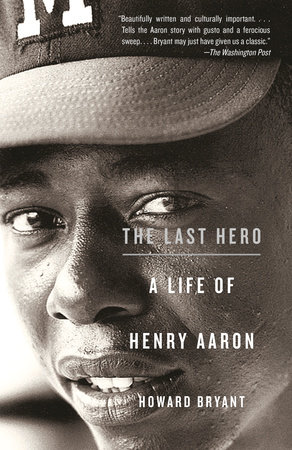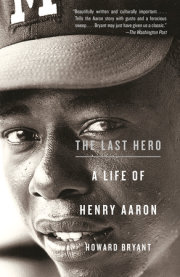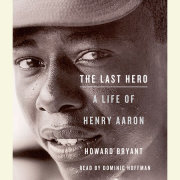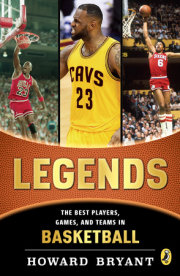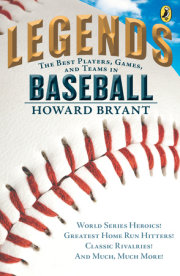Chapter Two HENRY Henry Aaron set out to be a professional baseball player, having hardly been an amateur one. At Central High, he had dabbled in football, and once, either in 1947 or 1948, he played a regular-season game against Westfield High and its sensational running back, Willie Mays. Central, however, had no baseball team, and Henry would not play football with great enthusiasm, for fear an injury would ruin his baseball prospects. He was expelled from Central, and was uninterested in anything but baseball while at Josephine Allen, which only fielded a softball team anyway. Henry’s résumé consisted of hitting bottle caps with a broom handle.
As he grew older and more prominent, journalists would seek to know more about his early years, about his upbringing and his family, about how he could have been so sure he possessed the special ability it took to play baseball at the highest level. A lot of kids were the best in their neighborhoods, but it wasn’t exactly a given that Henry was even
that. Henry would depend on a few of the old chestnuts that would be repeated for the next half century. The stories were odd and colorful, but none was particularly true or carried the kind of insight that would fill in the important pieces of his personal puzzle. At differing times, he told various tales about the origin of his legendary wrists. He told one writer that despite his wiry frame, his bulging forearms came from a job hauling ice in Mobile; he told another he benefited from mowing lawns; and he told people that for all of his right -handed greatness, he would have been an even
better switch-hitter. That was because he batted cross-handed, which for a right-handed hitter was to say with his left hand on top, as a left-handed hitter would.
In 1959, the writer Roger Kahn would attempt to profile Henry for
Sport magazine. He encountered the same frustration that sports editors of the Mobile newspapers had: Depending on the day, Henry would tell a different story about his origins, and, when placed side by side, no two stories ever exactly meshed.
Kahn was never quite sure if he found himself more frustrated by Henry’s early story or by Henry’s unwillingness to tell it. “I did not find him to be forthcoming,” Kahn recalled. “He wasn’t polished and really did not have the educational background at that time to deal with all of the things he was encountering in so short a time. If there was a word I would use to describe him then, it would be
unsophisticated.”
Even as a teenager, Henry was expressing his lack of comfort with public life. On subjects both complex and innocuous, he would not easily divulge information, and he developed an early suspicion of anyone who took an interest in him. The reason, he would later say, was not the result of any personal trauma, but, rather, that of growing up in Mobile, where the black credo of survival was to focus on the work and let it speak for itself. It was a trait that was equal parts Herbert and Stella. Not only did Stella remind him never to be ostentatious but Herbert and all black males in Mobile knew what could happen to a black man who drew too much attention to himself. “My grandfather used to say all the time, ‘They don’t want you to get too high. Know your place,’ ” recalled Henry’s nephew, Tommie Aaron, Jr. “I think a lot of that rubbed off on all of us.”
In fact, Henry would employ the recipe for star power best articulated in the old Western
The Man Who Shot Liberty Valance: “When the legend becomes fact, print the legend.” That, too, was fitting, because as a movie fan, Henry fell in love with Westerns. He did not volunteer much truth, so the scribes printed the legend. There was more than one drawback to Henry’s approach, however: As difficult as it was to piece together his early years, writers—virtually all of them white, carrying the prejudices against blacks that were common at the time—filled in the blanks for him, defined him, creating a caricature, from which he would not easily escape.
There was no magic moment to his childhood, no secret formula or bolt of lightning that transformed the broomstick -swinging boy into a baseball-playing man. He was not a particularly charismatic teenager, but he was single-minded. When he was not playing baseball, he spent his time on Three Mile Creek or in the pool halls of the Avenue, smoking with the adults.
Henry would occasionally cut the postage stamp of grass in front of the house. He would gather wood as Herbert demanded and he did his chores dutifully. Sometimes the two would clash, as fathers and sons do, over the future. Herbert, who earned sixteen cents an hour on Pinto Island, would have three quarters in his pocket and give his son two. There was, Herbert would say, an opportunity for Henry to have more than three coins in his pocket, to have, perhaps, an easier go of life if he would care more about school.
Like the rest of the Aaron children, Henry attended Morning Star Baptist Church, a mandatory requirement in Stella Aaron’s house. For his part, Herbert didn’t care much for the fire -and -brimstone carrying-on that was part of the tradition of the southern black Baptist Church. He preferred the more sober Episcopal Church, and attended somewhat regularly. After church, Henry would rush over to Carver Park, and that was where part of the legend was actually true.
In another place, just being a good ballplayer, better than the rest, would have been enough to attract the attention of someone who mattered—an influential college coach or one of the big-league scouts who seemed to know someone in every corner of the baseball-playing world. But Henry Aaron came of age in Mobile at a time when baseball was the lifeblood of the city, and being a good ballplayer in Mobile had all the distinction of a sunny day in California. It had been that way—for the odd, unquantifiable reasons that certain regions seem to breed highly skilled professionals of any stripe—since the 1920s. On the black side of town, before Henry’s time, there was Satchel Paige, who had come from Down the Bay—he’d lived on Alba Street—and became the most celebrated pitcher in the history of the Negro Leagues. There was the great Negro Leaguer Ted Radcliffe, who caught at one end of a doubleheader and pitched at the other so many times, they nicknamed him “Double Duty.” Radcliffe played for thirty-six years in the Negro Leagues. He and Paige were the big names of black baseball, but the culture of the sport was not rooted in the success of a couple of players. Across the tracks, on the white side of town, there were the Bolling brothers, Milt and Frank. Both would play in the big leagues, as would Henry and Billy Williams, but state law and local custom forbade interracial competition, and a generation of talented players lived in parallel universes.
Neighborhood kids would collide on the sandlots. On the black side of Mobile, the boys from Toulminville would play a group of kids from the other black areas, like Whistler or Plateau (which happened to be pronounced “Platt-toe”). Plateau was a depressed, historically rich, and significant part of Mobile. The town was nicknamed by the resident blacks “Africa Town,” because Plateau was the docking point for the
Clothilda, the final slave ship to land in Alabama. During Henry’s childhood, Africa Town was also the part of Mobile where many former slaves had relocated following Emancipation. In Plateau, when the Mobile establishment grew more determined to enact Jim Crow statutes, blacks founded the Hickory Club in 1906, a local organization formed to police black neighborhoods from within (black policemen were not hired in Mobile until the mid-1950s) but also, if necessary, to protect them from the Ku Klux Klan.
There was a boy from Plateau who happened to be best in that neighborhood. He was just a little kid at the time Henry was on the field in Toulminville, so Tommy Agee just watched the big kids play.
The boys from Whistler would ride their bikes (the ones who had bikes) over to Toulminville for weekend epics that would last on the Carver Park dirt for hours and in memory forever. Another kid, five years younger than Henry, used to sit and watch unless the teams weren’t even and they needed another body. When he got the call to play, Billy Williams would follow his big brother and do whatever he was told. The boys used their imaginations, the way kids do. Billy Williams recalled calling the dusty little park Carver
Stadium instead of Carver Park, to give the place its proper regality, lending dreams their proper setting.
Billy’s brother Clyde, a left -handed pitcher, often used to pitch to Henry. There was another younger kid in a different part of Mobile, Magazine Point, named McCovey, and people were already talking about keeping an eye on him, as well as another kid, Charley Pride, who wasn’t sure if he wanted to be a baseball player or a musician.
Mobile’s obsession with baseball was like something out of an old movie. Many of the factories in the city sponsored company teams, as did other industries. The men who played were grown and grizzled; they were welders and riveters and boilermakers in their mid-twenties and early thirties who ran down fly balls and threw in on the hands. Interspersed on these teams were some teenagers. Some of the kids could play, while others were bodies who filled out the rosters on days when numbers were short.
For a time, Henry played with the Pritchett Athletics, earning two dollars per game, and then he joined the Black Bears for three bucks a game. The traveling Negro League teams would come into town and play the industrial teams, and as a fifteen-year-old, Henry would play against Negro League competition. He played infield mostly, third base and shortstop, and as much as how he wielded the bat, players remembered the odd, slingshot style he used to throw the baseball, wide and to the side—“three o’clock,” Billy Williams said. Williams himself played against the adults, first on the Mobile Black Shippers as a teenager, and also on the Mobile Black Bears, the Negro equivalent of the minor-league Mobile Bears. Saturdays and Sundays would showcase doubleheaders. There was also another team, in a different part of the city, the Mobile Mohawks. The games were scheduled for 3:00 p.m., just after church. Willie McCovey played for the Mobile Buckeyes.
Periodically, Henry would have a chance to play in a game and dream a little bit bigger. Other times, he would have his ambitions temporarily broken, like the time he showed up at an open tryout held by the mighty Brooklyn Dodgers but couldn’t generate the nerve to stand up for himself and get in the batter’s box. The older kids intimidated him and he skulked off the field without ever holding the bat in his hands.
The story might have ended right there except for two important but underplayed factors: the confidence Henry possessed in himself to hit any pitch from any pitcher, and the sureness of a man named Ed Scott, who had been watching Henry since 1950, when Henry was sixteen. Henry was not a prodigy and had played in only a handful of organized games. Billy Williams remembered his demeanor as unchanged even then. “A lot of guys were playing a helluva baseball game. Every day, he didn’t stand out. He was just
good.”
There were bigger kids and more confident ones who might have been further along in their development at the time, but there was something about the way the ball sounded when Henry hit it, a sound the untrained ear might have missed. Ed Scott was convinced that the raw talent Henry displayed on the dusty sandlots of Toulminville might just be sufficient to allow him to play baseball at the next level.
Ed Scott worked in one of Mobile’s factories, but on the side he provided the eyes and ears for a Negro League team, the Indianapolis Clowns. Their time was essentially over, and everybody knew it. Robinson had integrated the big leagues, and the unintended—or, depending on whom you talked to and how much money was being taken from their pockets, the
intended—consequence of integration was the end of the black leagues. But in 1951, the Clowns could still attract young black ballplayers, and the major leagues still turned to the Negro Leagues as a source of talent. It was a relationship that would end before it began, for it would only be a matter of time before big -league clubs hired their own scouts to find black players.
Scott estimated he spent “every other day” with Henry. They would meet at Carver Park and Scott would shag flies for him. He believed Henry had a special ability, not simply because of Henry’s swing but also because he was able to make such consistent contact with crude equipment. “He could hit the ball with a broken piece of wood. That was hard to do,” Scott recalled. “Especially the black kids. You’d see them out there hitting and running and catching, with a tennis ball or broken pool stick. A broken pool stick was a Louisville Slugger to us.”
The more Scott talked to Henry about his ability, the more he understood that Henry was afraid of Stella. More to the point, he was afraid of telling his mother he wanted to find out if what Ed Scott was saying about him was true, that he truly did possess the ability to be a big -time baseball player. Scott recalled needing to summon all his courage to approach the Aaron household and confront the formidable Stella with his thoughts about her son’s future. On a few occasions, Scott would hide behind the side of the house. Stella Aaron sat on her porch. It was her favorite place at the house, her grandchildren thought.
In the fall of 1951, Scott made his case. Henry Aaron had the talent to go as far as he wanted as a baseball player. The Indianapolis Clowns were willing to give him a look. The Clowns were a legendary Negro League team, known for being the Harlem Globetrotters of baseball. The team featured good ballplayers but also high circus-style entertainment. Toni Stone, a woman, played second base. King Tut, an enormous man with a round belly, served as a mascot, wearing nothing but a grass skirt. If Henry made the club, the Clowns would pay him two hundred dollars per month, which was twenty-five dollars a week less than what Herbert brought in at ADDSCO. At first, Stella said no. After more discussion, the reality that college was not going to be an option settled in. Henry’s gaining a college education had been, understandably, a mother’s fantasy. The harder truth was that Henry had no interest in school and no track record as a student.
In those days, children in Mobile were not obligated to attend school for their senior year. Students could enter the workforce after eleventh grade. That rule created an opening: If he did not make it, Henry promised his mother, he would return to the Josephine Allen Institute for his final year. Stella agreed. Henry Aaron would then report to Winston -Salem to meet the Clowns. Bunny Downs, the Indianapolis business manager, would be at the depot to meet him. Unlike Stella, Herbert tended to lean toward Henry’s way of thinking. Perhaps Henry’s leaving Wilcox as a teenager to discover his own destiny influenced Herbert’s viewpoint.
Ed Scott recalled the difficulty in convincing Stella to let her son go. As much as she wanted Henry to attend college, she was also largely unaware of just how talented her son was.
“I told her, if this kid was Satchel Paige, I wouldn’t be bothering you,” Scott said. “But you really don’t know what you have.”
Copyright © 2010 by Howard Bryant. All rights reserved. No part of this excerpt may be reproduced or reprinted without permission in writing from the publisher.

